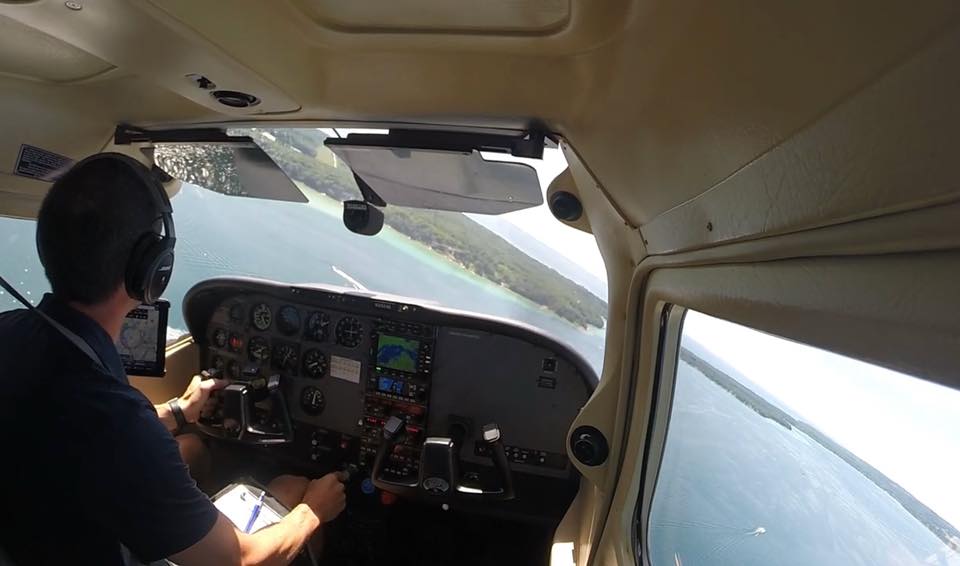If you do a search for flight schools in Michigan you will likely notice that there are not many near you and the ones that even might be do not offer flexible hours or may not even have availability in their schedule. There is however an alternative in the Flint, Michigan area that many people do not know even exists. A flying club is a non-profit organization that can offer the same benefits as a flight school thru a membership based fractional aircraft ownership. Greater Flint Pilot’s Association is one of those flying clubs and is located right at Flint Bishop Airport in Flint, Michigan.
Joining a flying club may sound a little complicated at first, but honestly it does not really get more simple than joining a local flying club. Flight Schools have their burdens including high costs, troubles scheduling, and usually a fleet of aircraft that is run hard. A local flying club like Greater Flint Pilots Association offers fractional ownership of a fleet of aircraft, lower overall costs of flying time, and the same pilots license can be achieved as a flight school.
Greater Flint Pilot’s Association also known as GFPA, has several members within the club that are flight instructors and hold CFI or CFII instruction certificates so if you are a member of the club you have access to their services. That means that you can be flying the fleet of aircraft at a lower operating cost and still get the same training that is offered at a Michigan Flight School. Many members of GFPA have seen savings of up to 30% achieving a private pilot license through GFPA versus a local flight school.

Choosing the instructor location to learn is one thing on it’s own, but then also comes choosing the aircraft you will fly during your lessons. This is where another big benefit comes into play with a flying club like GFPA over a flight school. GFPA for example currently has 4 aircraft in it’s fleet including a 2001 Cessna Skylane 182T, 2000 Cessna Skyhawk 172SP, 1982 Cessna Skylane 182RG, and a 1997 Piper Archer III. A lineup of aircraft like this can benefit members in many ways. One of the key ways it can help is that the experience pilots generally will be using the high performance 182’s which leaves the 172 and Archer III more available for training. This means that you will have more flexibility scheduling your flight training days and times which will get you in the cockpit more often and achieving your certificate quickly.
Now if you so choose to go with a flight school, you should take the time to do your research. Below is some great information provided courtesy of AOPA.org.
The Final Flight Training Decision
What flight school or flying club you ultimately choose depends on the quality flight training you desire in a method convenient to your schedule. In earning your private pilot’s certificate, you will have achieved a “license” to learn. Aviation is an ever-changing activity, and good pilots are always learning.
Perhaps the final deciding factor between several schools that are running in a dead heat is personality. Like people, flight schools have personalities. Some are deadly serious, while others are more familial in nature. Only you can select the one that matches your personality.
A Checklist for Choosing a Good Flight School or Flying Club
- Determine your aviation goals. Are you learning to fly for fun or do you plan to pursue a career?
- Compile a list of schools to examine, and request literature from each. Review material from each school and answer the questions outlined earlier here.
- Once you’ve done your “homework,” visit the final facilities that pass the test. Ask questions and get a feel for the personalities of the schools. Ask specific questions and insist on specific answers. Talk to other students and flight instructors.
- Once you’ve decided, be sure a written agreement outlines the payment procedures.
Interview the chief flight instructor or his or her assistant.
Some questions to ask:
- Are progressive flight-checks given? (These checks evaluate your progress during the pilot training program.)
- What’s the instructor-to-student ratio? (Generally speaking, an instructor can adequately educate four of five full-time students, or 10 or more part-timers, depending on their schedules.)
- Who schedules flying lessons, and how is it done?
- What are the insurance requirements of the school, and how do its liability and collision policies work? Will you be responsible for a deductible, and how much is that deductible in the event of a loss? What is your coverage as a student pilot?
- Who keeps your records? (This is important because poor documentation can cause you to repeat training.)
- What happens when weather or maintenance problems cancel a flying lesson? Who’s responsible for rescheduling lessons and reporting maintenance problems?
Final Thoughts
Take a good amount of time to do your research and make sure you visit the facilities you are considering as well as have them take you for a tour of the aircraft fleet. Ask to see a current schedule for the availability for aircraft and make sure that the instructors have the available time to take on a new student. Feel free to reach out to the GFPA membership director Harry Hammond at 810.629.5181 anytime to learn more about the benefits of our Flint, Michigan flying club and come see what we have to offer.